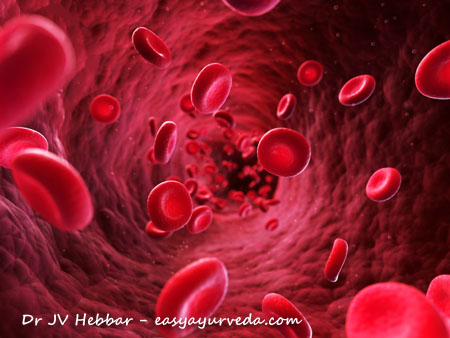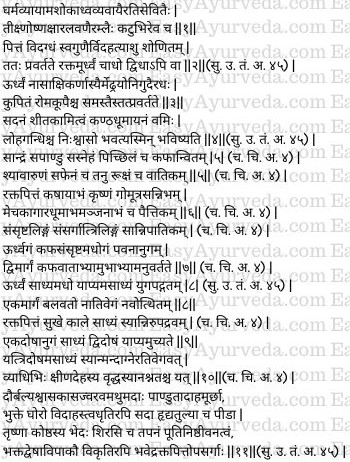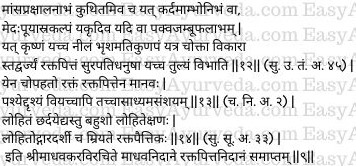Madhava Nidana Chapter 9 Raktapitta Nidanam
This article explains Madava nidaana 9th chapter “Raktapitta Nidanam”. Causes, pathology and symptoms of Raktapitta are explained in this chapter.
Read – Acharya Madhavakara: His Work ‘Madhava Nidana’, Legacy, Amazing Facts

Table of Contents
RakthaPittha Nidana, Samprapti
Etiological factors and pathogenesis of Raktapitta
Etiological factors of raktapitta include excessive exposure to sunlight, physical exercise, grief, walking long distances, excessive sexual intercourse; consumption of foods which are hot, alkaline, salty, sour and pungent.
Pathogenesis – All the above said causative factors when consumed lead to abnormal increase of pitta in its vidagdha state (by its uşna, tīksna properties). This aggravated pitta afflicts rakta – blood and quickly causes increase of blood and causes it to flow out of the body through upper or lower orifices or through both these orifices, viz, nostrils, eyes, ears and mouth being the upper passages and the urethra, vagina, rectum being the lower passages. In severe conditions, blood comes out of the hair follicles of the skin also.(1-3)
Read – Raktapitta Causes, Symptoms, Pathology, Treatment, Medicines, Remedies
Purvarupa
Premonitory symptoms of raktapitta
Weakness, desire for cold things (food, drink, places, etc.,) feeling as though hot fumes are coming out of the throat, vomiting, smell of iron in the breath – are the premonitory symptoms of Raktapitta. (4)
Sanskrit Versus

Dosha association in Raktapitta
- If kapha is associated, the blood coming out will be thick, yellowish, white, greasy and sticky.
- If vāta is associated, the blood will be blackish red, frothy, thin and viscid.
- If pitta alone is the cause, the blood coming out will be black resembling decoction of drugs, cow’s urine, and black pigment of a cymbal, chimney soot or antimony.
- If there is a combination of two or three doshas their specific symptoms are also found together. (5-6)
Read – Raktapitta: Cluster Of Bleeding Disorders: Meaning, Definition
Dosha association in raktapitta having upward (urdhwaga) and downward (adhoga) course
The Urdhwaga Raktapitta (having upward course with bleeding from upward orifices) is by association of kapha
The Adhoga Raktapitta (having downward course and bleeding occurring from downward orifices) is by association of vāta.
Kapha and Väta together will cause for both the upward and downward movement (bleeding) of raktapitta.(7)
Urdhwaga Raktapitta – Kapha dominant
Adhoga Raktapitta – Vata dominant
Ubhayaga – Kapha and Vata dominant.
Prognosis
Sadhya asadhyata
- Upward one (raktapitta having upward course) is easy to cure.
- Downward one (raktapitta having downward course) is manageable i.e. persists all through life and can be handled with effective treatments and medicines from time to time.
- Raktapitta having its course in both directions is incurable.
- Raktapitta is easy to treat, if bleeding occurs from any one passage, in persons who are strong, if bleeding is not large, if it is of recent origin, if seen in good season (favourable season for its cure) and if not associated with other complications. (8)
Raktapitta is easy to treat if only one dosha is associated, is manageable (persists for life) if two doshas are associated and incurable if all the three doshas are involved. Likewise in persons having poor digestive functions where bleeding is copious; in persons debilitated by other diseases, who are of advanced age and who do not take any food, raktapitta is incurable.
(9-10)
Read – Raktapitta Prognosis, Complications
Complications
Upadrava – complications of raktapitta
Debility, dyspnoea (increased / difficult respiration), cough, fever, vomiting, intoxication, pallor (yellowish-white discoloration), burning sensation, fainting, severe heart-burn after consumption of food, constant anxiety, severe pain near the heart, thirst, tearing pain in the abdomen, headache, bad smelling sputum coming out, aversion to food and indigestion and abnormal colour of the blood, are the complications of raktapitta. (11)
Read – Charaka Raktapitta Chikitsa – 4th chapter
Signs of incurability
- Patients in whom the blood coming out resembles water in which mutton has been washed, a decoction, muddy water with lot of silt, fat, pus, pieces of liver, ripe fruit of jambu (Eugenia jambolana), which is black or blue in color, which smells like a cadaver, or resembles a rainbow and who have one or more of the complications cited above – are to be refused treatment (i.e. in the presence of the above mentioned signs, raktapitta is considered as incurable and hence the physician shall refuse treating such patients). (12)
- If the patient (of raktapitta) sees everything visible (visible objects) and invisible (space, sky etc and those which doesn’t have any colour) as red in colour, raktapitta should be considered as incurable.
- If the patient of raktapitta vomits blood in large quantity, who sees everything as red, who gets belching accompanied with bleeding (or gets belching having the smell of iron) is going to die (i.e., such raktapitta conditions are definitely incurable and would lead to death). (13-14)

Thus ends the chapter on Raktapitta Nidanam in Madhava Nidana text written by Acharya Madhavakara.









